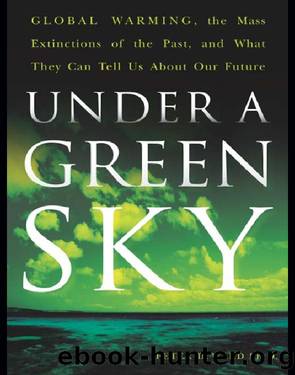Under a Green Sky: The Once and Potentially Future Greenhou by Peter D. Ward

Author:Peter D. Ward
Language: eng
Format: mobi
ISBN: 0061137928
Publisher: HarperCollins e-books
Published: 2008-01-01T23:00:00+00:00
A SHORT FERRY RIDE FROM SEATTLE LIES AN UPSCALE COMMUTER HAVEN called Bainbridge Island. Each morning thousands of suits take the 30-minute ride from suburbia to downtown offices and then rush back again at the end of the day. The tax base on the island, with its numerous waterfront and water-view houses is enormous, and why not—the view is sublime from the east side of the island looking at the magnificent cityscape of the downtown Seattle waterfront looming upward across two miles of Puget Sound. Even back in the Great Depression the wealthy valued this island, which became the site of the novel Snow Falling on Cedars, but not everyone who rides the boat to Bainbridge is a lawyer or plays golf. Some of the riders are students of various paleontology classes, for the southern tip of the island, on a closed country club, to be exact, is made up of 30-million-year-old sedimentary rocks that had been deposited on a fairly deep ocean bottom. Such outcrops are rare in the Seattle area, since the ice ages managed to dump untold tons of sand and gravel on the entire region repeatedly, covering the most useful teaching tools of a paleontologist, the rocks containing fossil life. The reason these outcrops are exposed is itself plenty ominous; the entire southern end of the island was thrown upward during the last mega earthquake that the region is prone to every 200 years or so. (The last was 200 years ago, and the tsunami wave generated by this monster quake crossed the ocean to devastate Japan, where its visitation was recorded in much art. Modern Seattle is a doomed city, each of its residents betting that a giant quake will not happen in our lifetimes. But what is life if not a gamble?)
The fossil-bearing rocks carry a salient message about the nature of the ocean back then: It was much like the ocean now—oxygenated from top to bottom—and we presume that this was maintained in some way by a conveyer current system analogous to that of today. By the Oligocene epoch of 30 million years ago, the world had cooled to something like its present state, after having been much warmer during the previous epoch, the Eocene. The ocean was warmer (as evidenced by a larger percentage of tropical snails and clams), but oxygen levels were the same at the bottom as at the top, and that has remained the case since. The abundance of life on the fossil bottom confirms that the oceans were animal-friendly from top to bottom, as does the fact that almost no bedding is visible in these rocks: On that ancient sea bottom a host of invertebrates managed to munch through the surface sediment to the extent that the original bedding was destroyed. We see this on the Bainbridge outcrops. No sedimentary bedding at all, just thick piles of well-sorted sediment rich in the shells of clams, snails, and other invertebrates. To a professional fossil finder, this kind of bottom is completely unlike the sea bottoms turned outcrops of older times.
Download
This site does not store any files on its server. We only index and link to content provided by other sites. Please contact the content providers to delete copyright contents if any and email us, we'll remove relevant links or contents immediately.
| Fossils | Game Theory |
| Genetics | Molecular Biology |
| Organic | Paleontology |
Sapiens: A Brief History of Humankind by Yuval Noah Harari(13052)
Sapiens by Yuval Noah Harari(4537)
Homo Deus: A Brief History of Tomorrow by Yuval Noah Harari(4278)
Pale Blue Dot by Carl Sagan(4001)
Origin Story: A Big History of Everything by David Christian(3139)
Livewired by David Eagleman(3121)
Brief Answers to the Big Questions by Stephen Hawking(2877)
Inferior by Angela Saini(2831)
Origin Story by David Christian(2683)
The Evolution of Beauty by Richard O. Prum(2553)
Signature in the Cell: DNA and the Evidence for Intelligent Design by Stephen C. Meyer(2501)
The Gene: An Intimate History by Siddhartha Mukherjee(2491)
Aliens by Jim Al-Khalili(2382)
How The Mind Works by Steven Pinker(2213)
Sex at Dawn: The Prehistoric Origins of Modern Sexuality by Ryan Christopher(2150)
From Bacteria to Bach and Back by Daniel C. Dennett(2148)
A Short History of Nearly Everything by Bryson Bill(2135)
Endless Forms Most Beautiful by Sean B. Carroll(2083)
Who We Are and How We Got Here by David Reich(2059)
